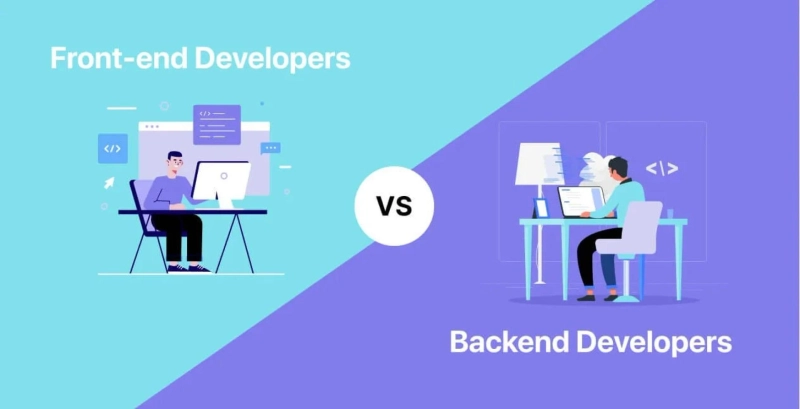In the world of full stack development, understanding the difference between frontend and backend is essential. These two core areas of web development contribute significantly to the creation of full stack applications. Whether you're a beginner or an experienced developer, knowing how frontend and backend work together will give you a deeper understanding of web development as a whole.
In this article, we will break down the key differences between frontend development and backend development and explore how they come together in full stack development to create modern web applications.
What is Frontend Development?
Frontend development refers to the part of a website or web application that users directly interact with. It’s the "client-side" of development, focusing on the elements that users see and engage with in their web browsers.
Key Aspects of Frontend Development:
- User Interface (UI): Frontend developers design and implement the visual elements like buttons, menus, text, and images that users interact with.
- User Experience (UX): Ensuring that the design is intuitive, user-friendly, and provides a smooth browsing experience.
- Languages and Technologies Used:
- HTML (HyperText Markup Language): The structure and layout of web pages.
- CSS (Cascading Style Sheets): Defines the look and feel, such as colors, fonts, and positioning of elements.
- JavaScript: Adds interactivity to websites, enabling dynamic behavior like form validation, animations, and real-time updates.
Frontend developers also use various frameworks and libraries to streamline their work, such as:
- React.js – A JavaScript library for building user interfaces.
- Angular – A comprehensive framework for building single-page applications.
- Vue.js – A progressive framework used for building modern web interfaces.
Front End Development Tools:
- Responsive Design: Ensuring that websites are adaptable and look great on any device, be it a smartphone, tablet, or desktop.
- Version Control (Git): Developers use tools like Git to manage code changes and collaborate with others efficiently.
What is Backend Development?
Backend development refers to the server-side of web applications, which users do not directly interact with. It involves everything that happens behind the scenes to deliver the data and functionality required by the frontend.
Backend developers focus on server-side logic, data management, and making sure that everything on the server works efficiently.
Key Aspects of Backend Development:
- Server-Side Logic: Handling client requests, processing them, and returning the appropriate data or response.
- Databases: Backend developers interact with databases to store, manage, and retrieve data (e.g., user profiles, products, or transactions). Common database types include SQL and NoSQL databases.
- APIs (Application Programming Interfaces): APIs allow communication between the frontend and backend, enabling the transfer of data and instructions.
Backend Programming Languages and Tools:
- Node.js – A JavaScript runtime built for server-side development.
- Python (with frameworks like Django or Flask) – Popular for backend services due to its simplicity and power.
- Ruby (using Ruby on Rails) – A dynamic framework for building web applications quickly.
- PHP – Widely used in web development, particularly for server-side scripting.
- Java – A long-standing language used for enterprise-level applications.
Backend development also involves working with various tools for server management, such as Docker and Kubernetes, and managing databases like MySQL, PostgreSQL, and MongoDB.
Full Stack Development: Bridging Frontend and Backend
A full stack developer is someone proficient in both frontend and backend development. This allows them to build a complete web application, handling both the client-side and server-side processes.
Responsibilities of a Full Stack Developer:
- Frontend Development: Building the visual and interactive components that users engage with.
- Backend Development: Handling the server-side logic, managing databases, and creating APIs to enable communication between the frontend and backend.
- End-to-End Application Development: Full stack developers can create entire applications, from the user interface to the backend, and ensure seamless integration between the two.
Advantages of Full Stack Development:
- Versatility: Full stack developers are capable of handling both frontend and backend tasks, making them invaluable in smaller teams.
- Cost-Effectiveness: With knowledge in both areas, a full stack developer reduces the need for multiple specialized developers.
- Seamless Integration: Full stack developers ensure that the frontend and backend work together smoothly, enhancing the overall user experience.
How Frontend and Backend Work Together
In a full stack development environment, the frontend and backend collaborate to create a seamless web experience. Here’s how they work together:
- User Interaction (Frontend): The user interacts with the frontend elements, clicking buttons, filling forms, and navigating content.
- Request to Backend: The frontend sends requests to the backend (via APIs or AJAX calls) to fetch data or perform actions.
- Backend Processing: The backend processes the request, retrieves data from the database, or performs calculations, and sends a response back to the frontend.
- Frontend Updates: The frontend updates the UI with the new data, giving the user real-time feedback and updates.
This back-and-forth communication between frontend and backend ensures that users get the best possible experience when interacting with web applications.
Conclusion
The primary difference between frontend and backend development lies in their focus: frontend deals with the user interface, while backend handles server-side logic, databases, and functionality. Full Stack Development combines both areas, enabling developers to create complete applications. Mastering both frontend and backend skills allows you to build powerful, scalable, and user-friendly web applications. To enhance your skills, consider enrolling in a Full Stack Development Training Course in Delhi, Noida, Lucknow, Nagpur, and other cities in India. These courses offer hands-on experience with essential technologies, helping you become a versatile developer capable of working on all aspects of Full Stack development.


